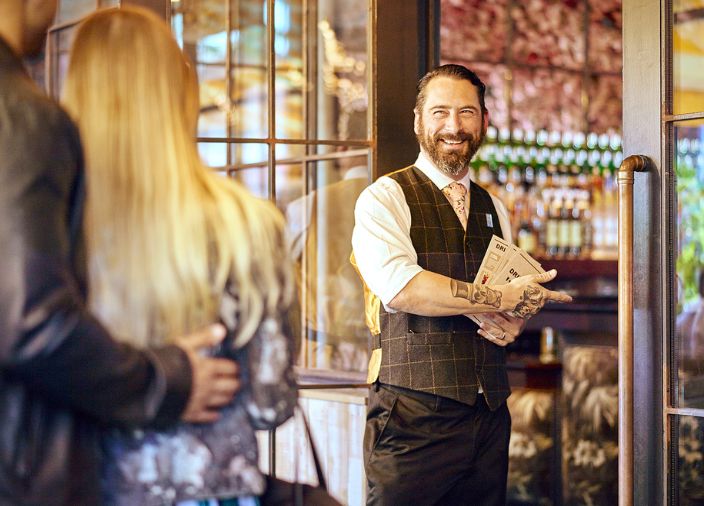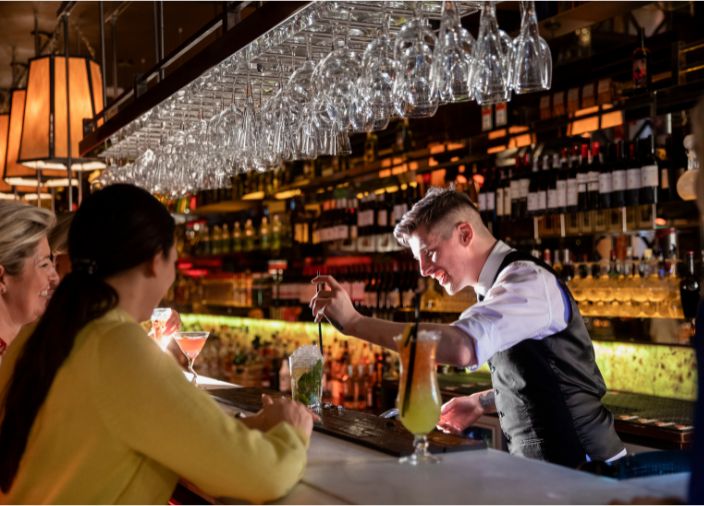
Essential Bar Skills: Communication
The art of great hospitality lies in great communication. By mastering both verbal and non-verbal communication, you can deliver truly memorable hospitality and can create an environment where guests feel welcome, respected and at ease.
Estimated reading time: 5 minutes
The art of great hospitality lies in great communication and it’s no coincidence that the world’s best bar professionals are also great communicators. Whilst there are fundamental service skills that also need to be mastered, mastering communication is fundamental to delivering great hospitality and a great guest experience.
Creating a memorable experience – the welcome and departure

Creating a memorable experience – the welcome and departure
The welcome and departure are emotional touch points in the guest journey where good communication plays a key role in the overall experience. The saying “first impressions last” holds true in hospitality and the initial moments of a guests’ visit will set the tone for their whole experience.
A warm and genuine welcome, where you remember a returning guest’s name or drinks preference, or acknowledge a previous visit, fosters a sense of connection and belonging, and immediately puts guests at ease, a feeling that will affect the rest of the time they spend in your venue.
On the other hand, a memorable departure leaves a lasting impression of gratitude and ensures guests leave on a high note. These emotional connections play a crucial role in shaping how guests remember their experience with you and the way you communicate at these critical touch points will ensure they associate positive feelings with you personally, and your venue.
Psychological research highlights the primacy and recency effects, which suggest that people tend to remember the first and last moments of an experience more vividly than the middle parts. A warm welcome and a fond farewell are often the first and last interactions a guest has with you, making them key components where good communication can leave a strong impression.
Verbal and non-verbal communication
Creating a comfortable and welcoming atmosphere for your guests involves effective verbal and non-verbal communication. There are key elements of each that you can use to make your guests feel at ease:
Verbal Communication

Verbal Communication
Active listening: Pay full attention to guests when they’re speaking. Respond with appropriate acknowledgements to who you’re engaged.
Empathy and Connection: Show genuine interest in guests’ preferences and experiences. Use empathy to understand their needs and preferences.
Clear Communication: Speak clearly and at an appropriate volume. Use simple language and avoid terms that might confuse guests.
Personalisation: Remember and use guests’ names if possible. Refer back to previous conversations to create a sense of familiarity.
Positive Language: Use positive words and phrases and avoid negative language or statements.
Offering Recommendations: Provide menu recommendations based on guests’ tastes and positively reaffirm their choices to make them feel valued.
Non-verbal Communication

Non-verbal Communication
Eye Contact: Maintain eye contact to show attentiveness. Avoid staring which can make guests feel uncomfortable.
Smiling and Facial Expressions: Greet guests with a warm smile to convey friendliness. Use appropriate facial expressions to match the conversation.
Body Language: Stand or lean slightly towards a guest to show engagement. Avoid crossed arms which can make you seem closed off.
Gestures: Use open and inviting gestures, such as open palms facing upwards. Avoid abrupt or aggressive gestures that might be off-putting.
Proximity: Maintain an appropriate distance from the guest and avoid invading their personal space.
Mirroring: Subtly mirror a guest’s body language to establish rapport. Avoid overdoing it as it can come across as insincere.
Attire and personal grooming: Dress professionally and ensure your uniform is clean and well ironed. Neat grooming reflects professionalism and cleanliness and should be non-negotiable for anyone stepping behind the bar.
PUTTING THE TWO TOGETHER
By mastering both verbal and non-verbal communication, you can deliver truly memorable hospitality and can create an environment where guests feel welcome, respected and at ease. These elements contribute to building rapport, establishing trust, and ensuring your guests have a positive experience in your venue.
Key Takeaways
A warm welcome and memorable departure are key to shaping how your guests feel while they are in your venue and remember it after they leave.
You can build these moments into your guest journey, drawing on psychological research to understand the most important moments and crucial actions you can take.
Verbal communication – carefully listening to, acknowledging, and personalising your conversations with guests – will help make them feel welcomed.
Non-verbal communication – eye contact, body language and presentation – also helps to create a comfortable atmosphere and relaxed experience.
Empower your team to keep up with industry trends, learn from the experts and discover invaluable resources for their bar career by encouraging them to sign up to the Diageo Bar Academy.
Related content

Communication & Teamwork
In this course, you’ll learn just how important effective communication really is within your team.
Creating a Memorable Customer Experience
Explore how you can create the best customer experience possible in your venue that makes guests come back time and time again, driving success for your venue.
Scheduling your team to optimise peak performance
Enable your bar team to achieve speed and efficiency during the most profitable hours.
The Laws of Attraction: Recruiting the Right Team
Discover how to develop a recruitment strategy to reduce staff turnover, build a happy team, and increase guest satisfaction and revenue.
